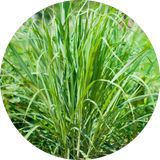- PLANT MEDICINE
- >
- Tinctures
- >
- LEMONGRASS TINCTURE
LEMONGRASS TINCTURE
Family: Poaceae
Genus: Cymbopogon
Species: citratus
Synonyms: Andropogon citratus, Cymbopogon flexuosus
Common Names: Lemongrass, Citronella Grass, Fever Grass
Parts Used: Leaves, Stems
Main Actions: Antimicrobial, Antioxidant, Anti-inflammatory, Antifungal
Other Actions: Antipyretic, Anticancer, Analgesic
Description: Lemongrass is a perennial grass with tall, slender stems and long, thin leaves. It emits a citrusy fragrance when crushed.
Tribal and Herbal Medicine Uses: Used traditionally for fever, digestive issues, muscle pain, and as a mosquito repellent.
- As a mild sedative, Lemongrass is an effective relaxant that acts as a central nervous system depressant assisting people under stress and hypertension; it is highly effective for the treatment of insomnia and other sleeping disorders, as it relieves the underlying tension and anxiety which make it difficult to fall asleep.
- Lemongrass also helps calm a nervous or upset stomach. Considered a bitter, it is said to help the gastrointestinal tract by easing indigestion, flatulence and stomach discomforts. It is also useful in relieving other gastrointestinal distress such as diarrhea, nausea, cramps and bloating.
- As an antifungal and antibacterial, Lemongrass is not only useful for gastrointestinal infections, such as gastroenteritis, but also acts as an effective cleanser that detoxifies the liver, pancreas and digestive tract. Furthermore, it works as a diuretic and is beneficial for the kidneys and bladder. It reduces excess uric acid, helps promote urination and helps to eliminate retained water. It also works as an antimicrobial for infections of these organs.
- Lemongrass is believed to dispel bacterial infections and is used to treat internal parasites. Externally, the herb is an effective treatment for lice, ringworm, athlete's foot and scabies, due to its larvicidal properties. It is also an insect repellent. Add a few drops to a little oil or salve to heal cold sores and genital or labial herpes. The herb has shown strong antibacterial activity against several human pathogens, and a study in 1988, found increased activity against E. coli and Staphylococcus aureus.
- Lemongrass is widely used as an analgesic and contains a powerful agent that reduces the sensation of pain. The herb relieves headaches, lower intermittent fevers and rids the lungs of mucus. It has been widely used to alleviate respiratory conditions, including laryngitis and sore throats. And it has earned a reputation for the anti-pyretic property that reduces high fevers. It also works as an analgesic for arthritic aches and pains, and sports injuries. The herb is also believed to relieve spasms, muscle cramps, menstrual cramps, joint pain, and rheumatism.
- Lemongrass supports the immune system, reduces uric acid, cholesterol and excess fats in the body. Its use may result in weight loss, as well as cleansing the system of fat.
- It helps to improve the skin and is used effectively for the treatment of acne and pimples.
- It has been used to treat various disorders of the nervous system such as Alzheimer's disease, shaky limbs, lack of reflexes, vertigo, Parkinson's disease and so on.
- Recent studies show that Lemongrass extracts may have cancer-fighting properties.
- This herbal remedy has been linked to an increase in the body's ability to repair damaged connective tissue such as ligaments, cartilage, and tendons. Another related benefit for this tincture is the improvement in blood circulation.
- Lemongrass is a tonic and supplement that is believed to be of great benefit to the skin and nails; it also helps to maintain balanced skin tone. The herb has also been found to be effective against cellulite, and actually helps tone tissues and muscle.
Plant Chemicals: Citral, Citronellal, Limonene, Geraniol, Nerol
Biological Activities and Clinical Research: Demonstrated antimicrobial, antioxidant, and anti-inflammatory properties in various studies.
Current Practical Uses: Culinary ingredient, herbal tea, essential oil production, natural insect repellent.
Main Preparation Method: Infusion, essential oil extraction.
Main Actions (in order): Antimicrobial, Antioxidant, Anti-inflammatory, Antifungal
Main Uses: Culinary, Medicinal, Aromatherapy, Pest Control
Properties/Actions Documented by Research: Antimicrobial, Antioxidant, Anti-inflammatory
Other Properties/Actions Documented by Traditional Use: Antipyretic, Anticancer, Analgesic
Cautions: Generally safe when used in culinary or aromatherapeutic amounts. Avoid excessive consumption.
Traditional Preparation: Infusions, decoctions, poultices, inhalation, topical applications.
Contraindications: None known at typical culinary or therapeutic doses.
Drug Interactions: None reported, but exercise caution with concurrent use of medications metabolized by cytochrome P450 enzymes.
Recommended dosage: 5ml - 10ml taken in a small glass of water or juice 2 x daily on an empty stomach for better absorption.



